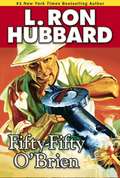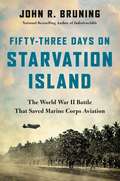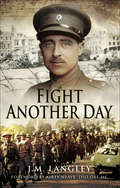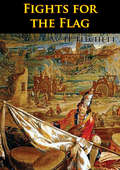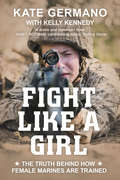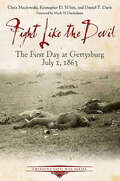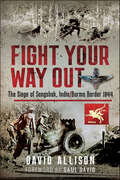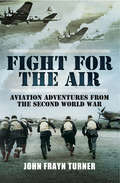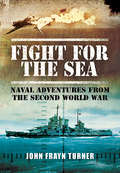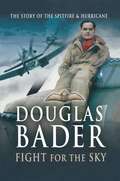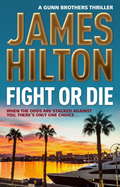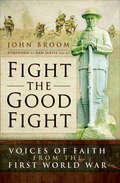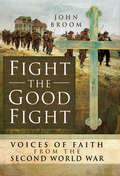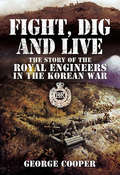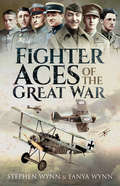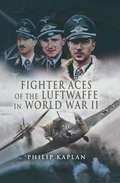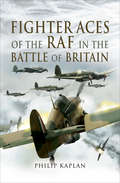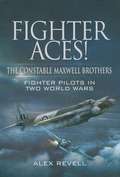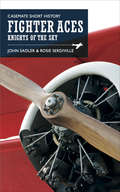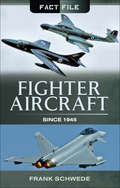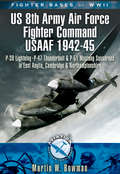- Table View
- List View
Fifty-Fifty O'Brien
by L. Ron HubbardWinchester Remington Smith is a crack shot. Problem is, surrounded by roller coasters and merry-go-rounds, his talent is going to waste, knocking down ducks in a carnival shooting gallery. Win wants some real action, and like Gary Cooper as Sergeant York, he's going to war--running off to join the U.S. Marines to fight a guerilla insurgency south of the border. In the jungles of Central America, Win takes a different kind of roller coaster ride. Quick and quiet, he's now a runner. It's a vital role, but he feels like a messenger boy, unable to put his rifle to good use. Even when he saves the life of First Sergeant Fifty-Fifty O'Brien--a Marine so gung-ho he has about a fifty-fifty chance of survival--Win ends up facing a disciplinary hearing for disobeying orders. Can the young sharpshooter redeem himself? Win's about to get his chance, an opportunity to deliver a message that the Marines will never forget.Hubbard knew exactly what it meant to be a Marine. As he wrote in 1935: "Most of the fiction written about [Marines] is of an intensely dramatic type, all do-or-die and Semper Fidelis." But the reality, he said, was far different. "I've known the Corps from Quantico to Peiping, from the South Pacific to the West Indies, and I've never seen any flag-waving. The most refreshing part of the U.S.M.C. is that they get their orders . . . and do the job and that's that." It's that kind of unique and pointed insight that he brings to stories like Fifty-Fifty O'Brien. Also includes the military adventures The Adventure of X, in which a French Foreign Legionnaire's intelligence mission leads him into an enemy ambush, and he has to warn his fellow Legionnaires before they walk into a massacre; and Red Sand, the story of a disgraced Chicago cop who joins the Legionnaires and finds his investigative skills invaluable in the desert.
Fifty-Three Days on Starvation Island: The World War II Battle That Saved Marine Corps Aviation
by John R BruningThe pivotal true story of the first fifty-three days of the standoff between Imperial Japanese and a handful of Marine aviators defending the Americans dug in at Guadalcanal, from the New York Times bestselling author of Indestructible and Race of Aces. On August 20, 1942, twelve Marine dive-bombers and nineteen Marine fighters landed at Guadalcanal. Their mission: defeat the Japanese navy and prevent it from sending more men and supplies to "Starvation Island," as Guadalcanal was nicknamed. The Japanese were turning the remote, jungle-covered mountain in the south Solomon Islands into an air base from which they could attack the supply lines between the U.S. and Australia. The night after the Marines landed and captured the partially completed airfield, the Imperial Navy launched a surprise night attack on the Allied fleet offshore, resulting in the worst defeat the U.S. Navy suffered in the 20th century, which prompted the abandonment of the Marines on Guadalcanal. The Marines dug in, and waited for help, as those thirty-one pilots and twelve gunners flew against the Japanese, shooting down eighty-three planes in less than two months, while the dive bombers, carried out over thirty attacks on the Japanese fleet. Fifty-Three Days on Starvation Island follows Major John L. Smith, a magnetic leader who became America&’s top fighter ace for the time; Captain Marion Carl, the Marine Corps&’ first ace, and one of the few survivors of his squadron at the Battle of Midway. He would be shot down and forced to make his way back to base through twenty-five miles of Japanese-held jungle. And Major Richard Mangrum, the lawyer-turned-dive-bomber commander whose inexperienced men wrought havoc on the Japanese Navy. New York Times bestselling author John R. Bruning depicts the desperate effort to stop the Japanese long enough for America to muster reinforcements and turn the tide at Guadalcanal. Not just the story of an incredible stand on a distant jungle island, Fifty-Three Days on Starvation Island also explores the consequences of victory to the men who secured it at a time when America had been at war for less than a year and its public had yet to fully understand what that meant. The home front they returned to after their jungle ordeal was a surreal montage of football games, nightclubs, fine dining with America&’s elites, and inside looks at dysfunctional defense industries more interested in fleecing the government than properly equipping the military. Bruning tells the story of how one battle reshaped the Marine Corps and propelled its veterans into the highest positions of power just in time to lead the service into a new war in Southeast Asia.
Fight Another Day
by J.M. LangleyAs a young subaltern in the Coldstream Guards, the author lost his arm at Dunkirk and was captured but eventually escaped via Lille, Paris, Marseilles, Spain and Gibraltar. He describes the fierce fighting outside Dunkirk, his captivity, escape and extraordinary life in Vichy France, before the Germans controlled it. His fellow escapees and the French who sheltered them make a rich cast of characters.On return to London, Langley is recruited into the Secret Service and told to organize the safe return of allied soldiers, sailors and airmen who had succeeded in either escaping from or evading the Germans. He describes the astonishing courage and sacrifice of the heroic underground operators who ran these escape lines across Belgium and France. Despite betrayal and infiltration from Germans, collaborators and traitors, over 3000 men were safely brought back to fight another day.Langley and Airey Neave, who joined him after his historic home run from Colditz, had to wrestle with rival secret organizations for resources to carry out their vital work.All this and more is brilliantly described in this gripping, beautifully written book.
Fight For The Flags [Illustrated Edition]
by W. H. FitchettIncludes 15 portraits and 14 mapsW. H. Fitchett brings to life some of the most notable clashes of arms between the British and the various enemies that they have fought against, from Minden to the Crimean War, from Blenheim to Salamanca."Fights for the Flag is as good as Deeds that Won the Empire. To say more than this in praise of the book before us is unnecessary, for Deeds that Won the Empire was one of the best collections of popular battle studies ever given to the public. Mr. Fitchett shows in Fights for the Flag all the good qualities which he showed in his first volume. There is the same admirable clearness of style, the same comprehensive sympathy, the same power to stir the blood and to paint noble deeds in fitting words. We note, too, the same excellent use of telling quotations. Whenever he can Mr. Fitchett gives what the Generals said in their own words, and not a mere rechauffé of their utterances. Thus Mr. Fitchett's work, though necessarily short and compressed, is never dull. Again, he shows here, as in his former book, the same power of describing localities and for bringing before one the place of battle. No writer ever had more completely the art of making one realise how opposing forces move both by land and sea."-The Spectator
Fight Like a Girl: The Truth Behind How Female Marines Are Trained
by Kelly Kennedy Kate GermanoOne woman's professional battle against systemic gender bias in the Marines and the lessons it holds for all of us.The Marine Corps continues to be the only service where men and women train separately in boot camp or basic training. This segregation negatively affects interaction with male marines later on, and, lower expectations of female recruits are actively maintained and encouraged. But Lieutenant Colonel Kate Germano arrived at the Fourth Recruit Training Battalion at Parris Island--which exclusively trains female recruits--convinced that if she expected more of the women just coming into Corps, she could raise historically low standards for female performance and make women better Marines. And, after one year, shooting qualifications of the women under her command equaled those of men, injuries had decreased, and unit morale had noticeably improved. Then the Marines fired her.This is the story of Germano's struggle to achieve equality of performance and opportunity for female Marines against an entrenched male-dominated status quo. It is also a universal tale of the effects of systemic gender bias. Germano charges that the men above her in the chain of command were too invested in perpetuating the subordinate role of women in the Corps to allow her to prove that the female Marine can be equal to her male counterpart. She notes that the Marine Corps' $35-million gender-integration study, which shows that all-male squads perform at a higher level than mixed male-female squads, flies in the face of the results she demonstrated with the all-female Fourth Battalion and raises questions about the Marine Corps' willingness to let women succeed.At a time when women are fighting sexism and systemic bias in many sectors of society, Germano's experience has wide-ranging implications and lessons--not just for the military but also for corporate America, the labor force, education, and government.
Fight Like the Devil: The First Day at Gettysburg, July 1, 1863 (Emerging Civil War Series)
by Chris Mackowski Daniel T. Davis Christopher D. White“Gives the reader an excellent readable narrative of the first day of battle . . . [and] an incredible driving tour which closes each chapter.” —Matthew Bartlett, Gettysburg ChronicleDo not bring on a general engagement, Confederate General Robert E. Lee warned his commanders. The Army of Northern Virginia, slicing its way through south-central Pennsylvania, was too spread out, too vulnerable, for a full-scale engagement with its old nemesis, the Army of the Potomac. Too much was riding on this latest Confederate invasion of the North. Too much was at stake.As Confederate forces groped their way through the mountain passes, a chance encounter with Federal cavalry on the outskirts of a small Pennsylvania crossroads town triggered a series of events that quickly escalated beyond Lee’s—or anyone’s—control. Waves of soldiers materialized on both sides in a constantly shifting jigsaw of combat. “You will have to fight like the devil . . .” one Union cavalryman predicted.The costliest battle in the history of the North American continent had begun.July 1, 1863 remains the most overlooked phase of the battle of Gettysburg, yet it set the stage for all the fateful events that followed.Bringing decades of familiarity to the discussion, historians Chris Mackowski, Kristopher D. White, and Daniel T. Davis, in their always-engaging style, recount the action of that first day of battle and explore the profound implications in Fight Like the Devil.“The book, written in the series’ accessible style, includes more than 100 illustrations, new maps and analysis.” —Longwood Magazine
Fight Your Way Out: The Siege of Sangshak, India/Burma Border, 1944
by David AllisonIn March 1944, Japan launched its audacious overland invasion of India from Burma. Taken by surprise, the British rear areas lay exposed and undefended except for the previously untested 50 Indian Parachute Brigade training in the jungle around Manipur. After a series of brutal encounter battles, the Paratroopers consolidated on the isolated Naga village of Sangshak high in the Manipur hills. Holding out against an aggressive and determined enemy, the Brigade fought off wave after wave of attacks in bloody hand-to-hand fighting. With shortages of ammunition and supplies and casualties mounting, the defenders held on for a critical week before fighting their way out through the mountainous terrain, back to British lines. Fight Your Way Out describes this little known but critical first major battle between Indian and Japanese armies on Indian soil. The siege is described in detail using first-hand accounts as is their daring escape through the jungle and the experiences of Indian and British survivors captured by the Japanese. The crucial battle of Sangshak cost the invaders precious time from which they never recovered and set the scene for their eventual defeat at the final battles of Kohima and Imphal.
Fight for Us: Win Back the Marriage God Intends for You
by Adam Davis Chad RobichauxFight for Ustakes couples on an inspiring journey into the challenges of battling for their marriage, through gut-wrenching times of despair, and then finally to the victory of a renewed relationship grounded in Jesus.Fight for Us delivers a compelling marriage challenge of "five rounds" that teach readers how to develop the never-give-up, never-quit mentality every relationship needs in order to combat the enemy's constant attacks.Utilizing narrative elements from the real-life story of Chad and Kathy Robichaux, readers will learn how Chad's deployments to Afghanistan as a Marine--and subsequent career as an MMA fighter--allowed him to disengage from his emotions, his marriage, and his children. Then, when his crippling PTSD brought him to brink of suicide, Kathy's pastor taught him the "five rounds" of fighting that are necessary in the battle for any marriage:Believe that God loves you and has a purpose for your life.Take responsibility for your actions.Accept that you can't change the evils that you've encountered.Access God's power.Put yourself second.At the end of the rounds, readers will discover God's design for marriage, which saved Chad and Kathy's relationship. Today, they aim to pay it forward and share what they've learned with other couples. Fight for Us features application sections, discussion prompts, affirmations, and Bible verses, all designed to help readers apply the book's key marriage principles.
Fight for the Air: Aviation Adventures from the Second World War
by John Frayn TurnerThis collection of popular air warfare stories covers the entire span of World War II, beginning when the Royal Air Force faced fascist forces on its own until the dropping of the Atomic bombs on the Japanese in 1945. Fight for the Air offers a rich mixture of accounts about such large and well-known battles and operations as the Battle of Britain, the huge Allied bomber raids over German cities, as well as more specialist operations such as the Dambusters. Individual feats of courage make for inspiring reading. The author's prose crackles with action and tension and his deep understanding of air warfare is obvious.These short stories give the reader an understanding of the global scope of air operations and their massive contribution to ultimate victory.
Fight for the Sea: Naval Adventures from the Second World War
by John Frayn TurnerThis collection of popular naval stories covers the entire span of World War II, beginning when the British Royal Navy faced fascist forces on its own until the final Allied victory over the Japanese in 1945. Fight for the Sea offers a rich mixture of accounts about such large and well-known battles and operations as the Battle of the Coral Sea, as well as lesser-known actions such as the submarine attack on Corfu harbour, the loss of the USS Leedsdown, and the saga of the USS Rich to characterize the breadth and variety of the war at sea. Also included are memories of John F Kennedy's heroic actions with PT 109 and George H W Bush's near-death experience with an aircraft known as the 'flying casket'.A sailor's eye view of the war at sea, this compelling compilation has broad appeal. John Frayn Turner's prose crackles with action and tension to keep the reader's attention, and even those who know little about the war will find the stories to be a welcome introduction to the subject. Among the book's special attractions are the little-known contributions of rescue ships and merchant seamen and the adventures of civilians, including Johnnie Ferguson, who spent three weeks adrift in an open boat when her ship was torpedoed. Readers will come away with not only a clear understanding of the giant scope of World War II but of the individual grit and determination that produced victory.
Fight for the Sky: The Story of the Spitfire and Hurricane
by Douglas BaderThe only book written by the legendary &“legless&” ace, the double amputee World War II fighter pilot immortalized by the film Reach for the Sky. In Fight for the Sky, Douglas Bader tells the inspiring story of the Battle of Britain from the viewpoint of &“The Few.&” Using superb illustrations he traces the development of the Spitfire and Hurricane and describes the nail-biting actions of those who flew them against far superior numbers of enemy aircraft. As an added bonus, other well-known fighter aces including Johnnie Johnson, &“Laddie&” Lucas and Max Aikten contribute to Douglas&’s book, no doubt out of affection and respect. This a really important contribution to RAF history by one of the greatest—and certainly the most famous—pilot of the Second World War.
Fight or Die: A Gunn Brothers Thriller
by James HiltonBrothers Danny and Clay Gunn were brought up an ocean apart. Both served in the military, and both know how to kill, taking work as private military contractors and freelance “fixers”.When old friends Pamela and Larry are being terrorised by a local gang, keen to scare them away from their beloved business, the brothers step up to help in any way they can. What should be a straightforward job turns ugly when another gang, with a formidable reputation for murder and trafficking, become involved, and suddenly Danny and Clay are thrown into the most trouble they’ve ever faced.But the Gunn brothers aren’t the type to break promises. They came to fight and if they can’t win they’ll die trying...
Fight the Good Fight: Voices of Faith from the First World War
by John Broom&“The inspiring stories of a number of very different characters who used their Christian faith to cope with their experiences of the First World War.&” —Jacqueline Wadsworth, author of Letters from the Trenches While a toxic mixture of nationalism and militarism tore Europe and the wider world apart from 1914 to 1919, there was one factor that united millions of people across all nations: that of a Christian faith. People interpreted this faith in many different ways. Soldiers marched off to war with ringing endorsements from bishops that they were fighting a Godly crusade, others preached in churches and tribunal hearings that war was fundamentally against the teachings of Christ. Whether Church of England or Nonconformist, Catholic or Presbyterian, German Lutheran or the American Church of Christ in Christian Union, men and women across the globe conceptualized their war through the prism of their belief in a Christian God. This book brings together twenty-three individual and family case studies, some of well-known personalities, others whose stories have been neglected through the decades. Although divided by nation, social class, political outlook, and denomination, they were united in their desire to &‘Fight the Good Fight.&’ &“John Broom looks at such beliefs during the first world war—the Tommies were always fighting for God, the king and their country . . . a fascinating study.&” —Books Monthly &“A detailed study of a usually hidden aspect of wartime social history, the topic of Christian faith. Fight the Good Fight has been meticulously researched and includes a wealth of previously unpublished material.&” —Come Step Back In Time
Fight the Good Fight: Voices of Faith from the Second World War
by John BroomThe Second World War challenged many of the concepts that had provided stability and unity in the world. As totalitarian regimes in Europe and Asia attempted to impose their world view on their neighbours, a struggle for what Winston Churchill described as `Christian civilisation took place on many fronts. On the home front, on land, on sea and in the air, as well as in the horrific concentration camps of Europe and prisoner of war camps in the Far East, people of a Christian faith found their beliefs challenged. However, for many this challenge provided an affirmation of that faith, as it provided a rock amidst the ever shifting sands of circumstance. This book contains the accounts of twenty such individuals, many drawn from previously unpublished sources. Their testimonies provide evidence that during a time of discord, disruption, dislocation and death, the Christian faith remained a key force in sustaining morale and a willingness to fight the good fight.Interesting Facts King George VI called National Days of Prayer during Britains darkest days in 1940Had Michael Benn survived the war, he would have become the 2nd Viscount Stansgate, meaning his brother, Tony, would not have had to fight to renounce his peerageBill Frankland avoided near certain death at the Alexandra Hospital Massacre by the toss of a coinStanley Warren only found out about the rediscovery of his Changi Murals during a chance work conversation in the 1950sAs a boy, Ken Tout was told by his parents to cross the street to avoid walking past the Catholic church. As a man he was invited to a private audience with Pope John Paul II.
Fight to the Finish
by Jeanette MurrayThe author of Against the Ropes takes her First to Fight series another round with a novel of a JAG officer who loses his cool, when love delivers a knockout punch... Kara is a single mom working hard to keep life running smoothly for herself and her son, but a custody battle is wearing her down. When her friend suggests asking a JAG officer for some unofficial advice, Kara agrees--and soon finds herself officially head over heels... As a Judge Advocate, Graham has seen his share of nasty custody disputes--and he plans on keeping his distance from this one. But this purposeful, passionate woman has a way of drawing him ever closer to the edge. And when Kara's ex starts to throw his weight around, Graham will have to choose between toeing the line or stepping into the ring...
Fight to the Finish
by Tim CookThe magisterial second volume of Tim Cook's definitive account of Canadians fighting in the Second World War. Historian Tim Cook displays his trademark storytelling ability in the second volume of his masterful account of Canadians in World War II. Cook combines an extraordinary grasp of military strategy with a deep empathy for the soldiers on the ground, at sea and in the air. Whether it's a minute-by-minute account of a gruelling artillery battle, vicious infighting among generals, the scene inside a medical unit, or the small details of a soldier's daily life, Cook creates a compelling narrative. He recounts in mesmerizing detail how the Canadian forces figured in the Allied bombing of Germany, the D-Day landing at Juno beach, the taking of Caen, and the drive south. Featuring dozens of black-and-white photographs and moving excerpts from letters and diaries of servicemen, Fight to the Finish is a memorable account of Canadians who fought abroad and of the home front that was changed forever.
Fight, Dig and Live: The Story of the Royal Engineers in the Korean War
by George CooperThe Korean War, which began with an unprovoked attack by North Korea in 1950, went on for three long years. Over 100,000 soldiers of the United Nations forces, including those of the Republic of Korea, were killed and three times that number wounded. United Kingdom casualties amounted to some 300 Officers and 4,000 Other Ranks. The Royal Engineers deployed a Field Squadron to Korea in the Autumn of 1950 and this was expanded to a Regiment the following year. Involved in fierce fighting, the Sappers suffered grievous casualties including 42 killed and several hundred wounded. Their gallantry was rewarded by numerous gallantry awards, including two DSOs, thirteen MCs, (one by the author), eight MMs and the most distinguished of all, a Distinguished Conduct Medal, second only to the Victoria Cross.It was a vicious war whose intensity never slackened and in the last two months alone the Communist artillery fired over 700,000 rounds against 4.7 million fired back by the United Nations. The Royal Engineers were involved at all levels, from patrols and minefields, to defense works and, providing support to all manner of operations such as transportation, bridging and the important provision of postal services, so vital for morale. Inevitably, though, the focus in that of a war like Korea is often on sapper participation in the forward area where they were often involved in close-quarter fighting with the enemy. Sappers certainly lived up to the title of this book: Fight, Dig and Live.
Fighter Aces of the Great War
by Stephen Wynn Tanya WynnHistory has recorded that the first ever powered flight took place at Kitty Hawk in America, on 17 December 1903 and was carried out by the Wright brothers, Orville and Wilbur, who were aircraft designers and manufacturers. By the time of the outbreak of the First World War, aviation was only eleven years old. The daddy of battlefield warfare until that point in time had been the cavalry, a position it maintained even as war was declared on the Western Front. Aircraft were not initially seen as an offensive weapon and were instead used by both sides as observation platforms, or to take aerial photographs from. Even when they were eventually used in an offensive capacity, they did not have machine guns attached to them; if the crew wanted to open fire then they had to use a pistol or rifle. As the war progressed so the use of aircraft changed from being an observational tool, to that of a fighter and bomber aircraft - something that had never been foreseen at the outbreak of the war. The book then looks at the fighter aces from all sides. These were pilots who had been credited with shooting or forcing down a minimum of five enemy aircraft, of which their were hundreds. While some of these aces survived, many of them were killed. The most famous fighter ace of all is without doubt the German pilot known as the Red Baron, Manfred von Richthofen.
Fighter Aces of the Luftwaffe in World War II
by Philip KaplanThis book examines the reality behind the myths of the legendary German fighter aces of World War II. It explains why only a small minority of pilots - those in whom the desire for combat overrode everything - accounted for so large a proportion of the victories. It surveys the skills that a successful fighter pilot must have - a natural aptitude for flying, marksmanship, keen eyesight - and the way in which fighter tactics have developed. The book examines the history of the classic fighter aircraft that were flown, such as the Messerschmitt Bf 109 and the Focke Wulf Fw 190, and examines each type's characteristics, advantages and disadvantages in combat. The accounts of the experiences of fighter pilots are based on archival research, diaries, letters, published and unpublished memoirs and personal interviews with veterans. The pilots included are Werner Molders, Gunther Rall, Adolf Galland, Erich Hartmann and Johannes Steinhoff.
Fighter Aces of the RAF in the Battle of Britain
by Philip KaplanAce fighter pilots from the British Royal Air Force share stories from the experiences during World War II’s Battle of Britain.This book examines the reality behind the myths of the legendary RAF fighter aces during the Battle of Britain. It explains why only a small minority of pilots those in whom the desire for combat overrode everything accounted for so large a proportion of the victories. It surveys the skills that a successful fighter pilot must have a natural aptitude for flying, marksmanship, keen eyesight and the way in which fighter tactics have developed. The book examines the history of the classic fighter aircraft that were flown, such as the Spitfire and Hurricane, and examines each types characteristics, advantages and disadvantages in combat.The accounts of the experiences of fighter pilots are based on archival research, diaries, letters, published and unpublished memoirs and personal interviews with veterans.The pilots included are Robert Stanford Tuck, Adolph Sailor Malan, Geoffrey Page, Al Deere, Peter Townsend and Brian Kingcome.
Fighter Aces!: The Constable Maxwell Brothers: Fighter Pilots in Two World Wars
by Alex RevellWhen Gerald Constable Maxwell was flying as a fighter pilot in World War I, his brother Michael was born. Both went on to have distinguished flying careers in World War II. This is the story of both men and how their paths crossed during the second conflict.Gerald served with distinction with 56 Squadron, one of the crack fighter units of WWI in France. Upon his return to England he became Chief Flying Instructor of No. 1 Fighter and Gunnery School at Turnberry. In World War II he served as Station Commander at RAF Ford, a night Fighter station near Arundel, one of the most efficient and happy stations in 11 Group.Michael followed in his brothers footsteps and joined 56 Squadron in April 1940 to fly the Hawker Hurricane. During May the squadron was moved to France to assist the fast retreating British and French forces as the Germans rapidly advanced. On 27 May, he was shot down whilst attacking ten Heinkel 111s on their way to bomb Dunkirk. Fortunately his first contacts upon landing by parachute were French and he managed to find his way to Ostend where he boarded a trawler and crossed the Channel back to Deal.56 Squadron had by now returned to their English base at North Weald from where they were flying patrols over the French coast and escorting RAF bombers raiding the German positions. On 8 June, whilst trying to reach returning Blenheims over Le Treport, the Hurricanes were bounced by Bf 109s and again Michael was hit, wounding him in the leg and foot, fortunately he eventually managed a crash landing back at North Weald. During the height of the Battle of Britain Michael was again forced to make a crash landing near Herne Bay which he was lucky to survive as his Hurricane had disintegrated around him.In the autumn of 1941 Michael was posted to 604 Nightfighter Squadron, led by the legendary Cats Eyes Cunningham flying Beaufighters and eventually Mosquitos. He was eventually to Command the squadron whose tally of enemy aircraft shot down when he left it had reached 100. This remarkable story includes first-hand combat accounts from both Michael and Gerald and the author has had access to the Constable Maxwells family records.
Fighter Aces: Knights of the Skies (Casemate Short History)
by John Sadler Rosie SerdivilleA readable and entertaining introduction to aerial combat in the series that &“would be excellent for someone with an early interest in military history&” (Army Rumour Service). Just over a decade after the first successful powered flight, fearless pioneers were flying over the battlefields of France in flimsy biplanes. Though the infantry in their muddy trenches might see aerial combat as glorious and chivalric, the reality was very different and undeniably deadly: new Royal Flying Corps subalterns in 1917 had a life expectancy of eleven days. In 1915 the term &“ace&” was coined to denote a pilot adept at downing enemy aircraft, and top aces like the Red Baron, René Fonck, and Billy Bishop became household names. The idea of the ace continued after the 1918 Armistice, but as the size of air forces increased, the prominence of the ace diminished. But still, the pilots who swirled and danced in Hurricanes and Spitfires over southern England in 1940 were, and remain, feted as &“the Few&” who stood between Britain and invasion. Flying aircraft advanced beyond the wildest dreams of Great War pilots, the &“top&” fighter aces of World War II would accrue hundreds of kills, though their life expectancy was still measured in weeks, not years. World War II cemented the vital role of air power, and postwar innovation gave fighter pilots jet-powered fighters, enabling them to pursue duels over huge areas above modern battlefields. This entertaining introduction explores the history and cult of the fighter ace from the first pilots through late twentieth-century conflicts, which leads to discussion of whether the era of the fighter ace is at an end.
Fighter Aircraft Since, 1945 (Fact File)
by Frank SchwedeThe world's first jet engines were already available shortly before the end of the Second World War, but they had not been developed to a high enough standard to take part. This changed after 1945 when, on both sides of the Iron Curtain, one technological development surpassed the others and records tumbled almost every week. The era of the piston engine was finally over and jet fighters now dominated the skies. By the mid-1950s their speed had already reached double that of the speed of sound; an achievement which a few years earlier, would have sounded to many like science fiction.
Fighter Aircraft Since, 1945 (Fact File)
by Frank SchwedeThe world's first jet engines were already available shortly before the end of the Second World War, but they had not been developed to a high enough standard to take part. This changed after 1945 when, on both sides of the Iron Curtain, one technological development surpassed the others and records tumbled almost every week. The era of the piston engine was finally over and jet fighters now dominated the skies. By the mid-1950s their speed had already reached double that of the speed of sound; an achievement which a few years earlier, would have sounded to many like science fiction.
Fighter Bases of WW II US 8th Army Air Force Fighter Command USAAF, 1943–45: P-38 Lightning, P-47 Thunderbolt and P-51 Mustang Squadrons in East Anglia, Cambridgeshire and Northamptonshire
by Martin W. BowmanThis book covers the bases used during the Second World War by the American fighter units that flew in support of the 8th Air Forces heavy bomber forces.The long-range Lightnings, Thunderbolts and Mustangs escorted the Mighty Eighths Flying Fortresses and Liberators on their deep penetration raids into occupied Europe and Germany. Fighter cover was vital, since the USAAF flew daylight raids and in the early months the number of US aircraft lost to the defending Luftwuffe fighters was unacceptably high.The airfields included are Bodney, Bottisham, Boxted, Debden, Duxford, East Wretham, Fowlmere, Halesworth, Honington, Horsham St. Faith, Kings Cliffe, Leiston, Martlesham Heath, Raydon, Steeple Morden, Wattisham and Wormingford.This book looks at the history and personalities associated with each base, what remains today and explores the favorite local wartime haunts where aircrew and ground crew would have sought well-deserved entertainment and relaxation. Other museums and places that are relevant will also be described and general directions on how to get them included.
